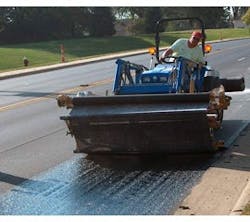The 20-ft-wide streets of Westlake, Ohio, had centerline and transverse joints every 25 feet that were randomly failing. Due to reflective cracking, concrete streets with asphalt overlays tend to have short service lives—ten years or less—and expensive pavement maintenance afterward. Westlake’s challenge was to increase the lifecycles of resurfaced streets and decrease maintenance costs by reducing the number of joint repairs, reinforcing the resurfaced asphalt and waterproofing the pavement.
“We always had to come through and remove the bad joints, and then do a full-depth concrete repair, and then do an asphalt overlay. It was very costly,” said Robert Kelly, director of engineering for the City of Westlake. “We were looking to do some value engineering so we didn’t have to do so much concrete joint repair.”
The streets in the various Westlake subdivisions had old, deteriorated concrete pavement and many joints and broken slabs that were in need of repair before resurfacing could occur. The worse the condition of the joints, the more expensive the repairs required prior to resurfacing. Conventional resurfacing without any reinforcement had not yielded favorable long-term results. “If we overlaid those streets without doing any joint repair, we’d immediately get a reflective crack from the concrete up through the asphalt within the first six months to a year,” said Kelly, who estimated that standard full-depth concrete repair would cost $70 per square yard.
So the City of Westlake used the GlasPave 50 Paving Mat—a hybrid geosynthetic paving material made of fiberglass mesh embedded into high-performance polyester mats—to resurface concrete streets in various neighborhoods. By using GlasPave 50, the project team could mill off some of the top surface of the street, clean the joints, proof-roll the street to ensure structural integrity and top-coat the surface without worrying about reflective cracks throughout the development. The technology from Tensar also waterproofs the pavement, which decreases the effect of freeze-thaw cycles and thermal pavement damage.
“We probably ended up saving 25%, if not more, on the overall construction cost and got a better finished product by using GlasPave 50,” Kelly said. “It has become a valuable tool in our road maintenance program. We could not be happier with the money saved, the construction project speeds up, the road is not torn up as much, the finished project is better and the long-term maintenance of the roadway is reduced. The product is one of the best new engineered pavement technologies that I’ve seen come out in the last 20 years.”



